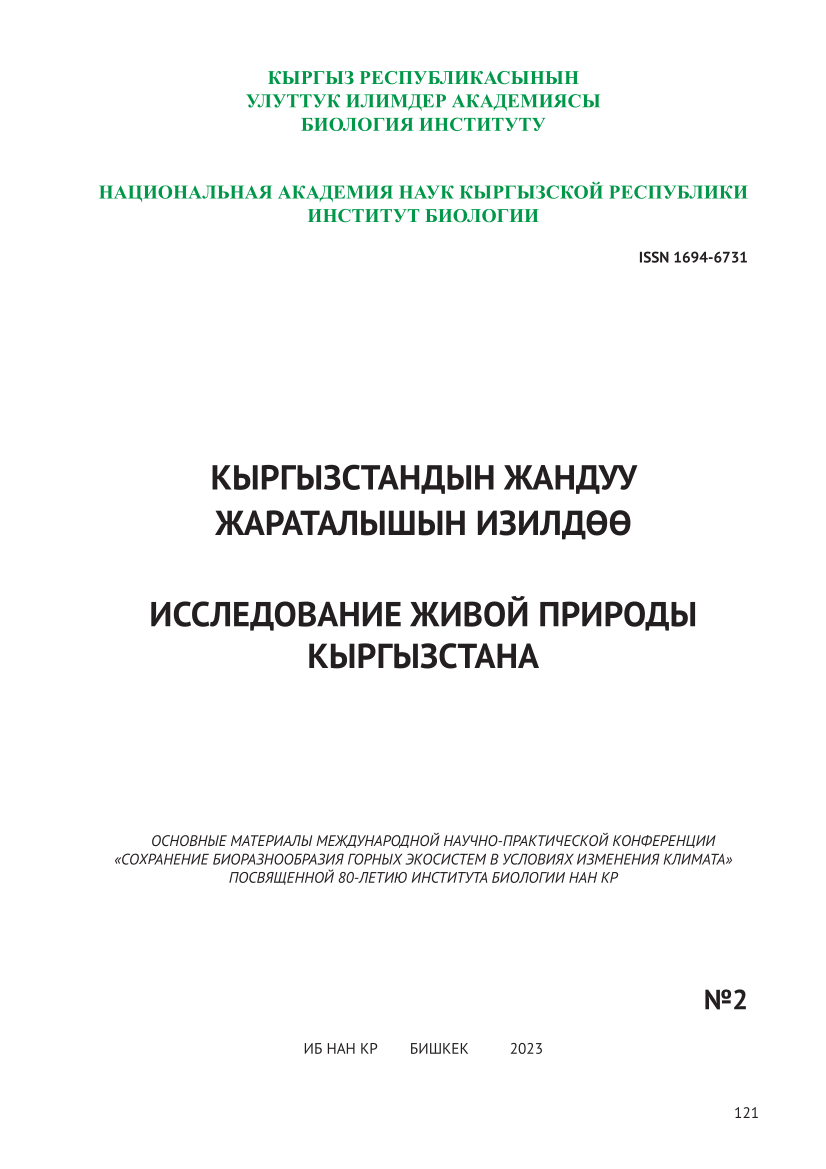GRAZING IS THE MAIN THREAT TO THE STABILITY OF POPULATIONS OF RANODON SIBIRICUS (AMPHIBIA, HYNOBIIDAE) IN THE CENTRAL PART OF THE SPECIES RANGE (KAZAKHSTAN)
Keywords:
Semirechensk Salamander, anthropogenic threats, grazing, habitat degradationAbstract
: The article summarizes the results of monitoring of Semirechensk Salamander (Ranodon
sibiricus) populations and their habitats in the central part of the species’ range in Kazakhstan in 2021.
Distant cattle breeding is considered the main reason for the serious degradation of salamander’s
habitats, and the death of amphibians and their clutches. Attention is emphasized on the urgency of
creating a protected area to conserve the species in situ.
References
Bannikov A.G. On the biology of Ranodon sibiricus // [Reports of Academy of Sciences of
USSR]. – 1949. – Vol. 65. – No. 2. – P. 237-240 [in Russian].
Bayle A., Carlson B.Z., Thierion V., Isenmann M., Choler P. Improved mapping of mountain
shrublands using the Sentinel-2 red-edge band. Remote Sensing. – 2019. – Vol. 11. – No. 2807. https://
doi.org/10.3390/rs11232807
Brushko Z.K., Kubykin R. A., Narbayeva S.P. 1988. Recent distribution of Siberian Salamander
Ranodon sibiricus (Amphibia, Hynobiidae) in Dzhungarian Alatau // Zoologichesky Zhurnal. – 1988. –
Vol. 63. – No. 1. – P. 1753-1755 [in Russian].
Chen S.–Y., Zhang Y.–J., Wang X.–L., Sun J.–Y., Xue Y., Zhang P., Zhou H., and Qu L.-H. 2012.
Extremely low genetic diversity indicating the endangered status of Ranodon sibiricus (Amphibia:
Caudata) and implications for phylogeography // PLoS ONE. – 2012. – Vol. 7. – No. 3. e33378. https://
doi.org/10.1371journal.pone.0033378
Cheremnov D.V., Dujsebayeva N.N., Cheremnov V.E., Dossbolov U.K. First results of comparative
monitoring of the American Mink (Neovison vison) and the Semirechensk Salamander (Ranodon
sibiricus) in the Junggarian Alatau (Kazakhstan) // Selevinia. – 2015. – No. 23. – P. 159-165 [in Russian
with English resume].
Dolmen D., Arnekleiv J.V., Kubykin R.A. and Mikutavichus D. Habitats and threats to the red
list species Ranodon sibiricus (Hynobiidae). Abstracts of the Second World Meeting of Herpetology. –
– (29th December 1993 – 6th January 1994, Adelaide, Australia). – P. 74.
Dolmen D., Kubykin R. A., and Jo V. Arneklein. Diel activity of Ranodon sibiricus (Amphibia:
Hynobiidae) in relationship to environment and treats // Asiatic Herpetological Research. – 1999. –
No. 8. – P. 29-37.
Dujsebayeva T.N. Results of monitoring of Ranodon sibiricus Kessler, 1866 (Amphibia: Caudata:
Hynobiidae) populations in the southern part of the area // Trudy Zoologicheskogo Inst. RAS. – 2013a.
– Vol. 317. – No. 2. – P. 151-175 [in Russian].
Dujsebayeva T.N. Final report of the grant project “Ranodon sibiricus Kessler, 1866: Monitoring
study at the early XXI century with goal to establish and substantiate protected territory”, supported
by the STIFTUNG ARTENSCHUTZ’s “Amphibian Funds” in cooperation with the Verband Deutscher
Zoodirektorene. V. (VDZ) and co–funding zoological gardens. 2013b.
Dujsebayeva T.N., Malakhov D.V. 2017. The model of Ranodon sibiricus ecological niche: GIS
and Remotely Sensing Approach // Russian Journal of Herpetology. – Vol. 24. – No. 3. – P. 171-192.
https://doi.org/10.30906/1026-2296-2019-24-3-171-192
Eisfelder C., Kuenzer C., Dech S. Derivation of biomass information for semi–arid areas using
remote–sensing data. International Journal of Remote Sensing. – 2012. – Vol. 33. – No. 9. – P. 2937-
IPCC, 2014: Climate Change: Synthesis Report. Contribution of Working Groups I, II and III to
the Fifth Assessment Report of the Intergovernmental Panel on Climate Change (Core Writing Team,
R.K. Pachauri and L.A. Meyer (eds.). – Geneva, Switzerland: IPCC. – 2014. – 151 p.
Kubikyn R.A. 1986. On the ecology of the Semirechensk Salamander // Rare Animals of
Kazakhstan. – Almaty: Nauka. – P. 187-191 [in Russian].
Kuzmin S.L., Xiuling W., Ishchenko V.G., Tuniyev B.S. 2004. Ranodon sibiricus. The IUCN Red
List of Threatened Species 2004:e.T19304A8851144. https://dx.doi.org/10.2305/IUCN.UK.2004.RLTS.
T19304A8851144.en Downloaded on 05 July 2021
Kuzmin S.L., Kubykin R.A., Thiesmeier B., Greven H. The distribution of the Semirechensk
Salamander (Ranodon sibiricus): a historical perspective // Advances in Amphibian Research in the
Former Soviet Union. – Sofia – Moscow: Pensoft, 1998. – P. 1-20.
Nishikawa K., Dujsebayeva T., Matsui M., Yoshikawa N., Tominaga A. Historical demography
of an endangered salamander, Ranodon sibiricus (Amphibia, Urodela, Hynobiidae), a reassessment //
Zoological Science. – 2017. – Vol. 34. – P. 18-25. https://doi.org/10.2108/zs160099
Shnitnikov V.N. Some data on Semirechensk Newt (Ranidens sibiricus Kessl.) // Ezhegodnik
Zoologicheskogo Muzeya Akademii Nauk. – 1913. – Vol. 18. – No. 53. – P. 53-61 [in Russian].
Vescovo L., Wohlfahrt G., Balzarolo M., Pilloni S., Sottocornola M., Rodeghiero M., Gianelle D.
New spectral vegetation indices based on the near–infrared shoulder wavelengths for remote
detection of grassland phytomass // International Journal of Remote Sensing. – Vol. 33. – No. 7. – P.
-2195.
Vilesov E.N., Morozova V.I., Seversky I.V. Glaciation of Jungar (Zhetysu) Alatau: Past, Present,
Future. – Kazakh State Univ. Press, 2013. – Almaty [in Russian].
Yang G.Y., Zhang L. Research on Ranodon sibiricus Kessler living conditions and imminent
danger degree and protection // Environmental Protection of Xinjiang. – 2006. Vol. 28. P. 19-21.
Yang G.Y., Wang X.L. Reason analysis on decreasing number of Ranodon sibiricus and
conservative strategies // Journal of Xinjiang Normal University (Natural Sciences Edition). – 2009. –
Vol. 28. – P. 15-18.

